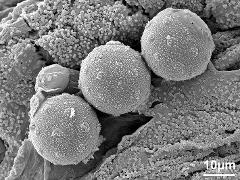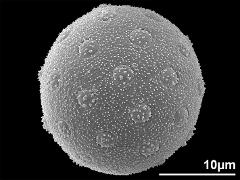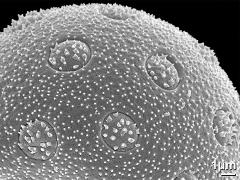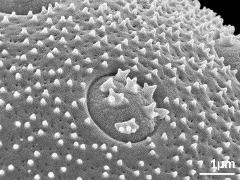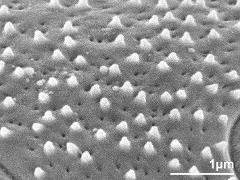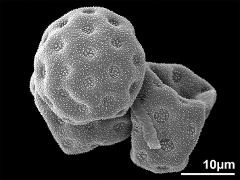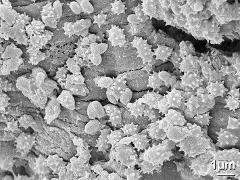Amaranthus blitum
Taxonomy: Angiospermae, Caryophyllales, Amaranthaceae, Amaranthus
Annotations: ssp. emarginatus
Published: 2015-11-10
Pollen Description
Shape, Size and Aperture
pollen unit: monad, dispersal unit and peculiarities: monad, size (pollen unit): small (10-25 µm), size of hydrated pollen (LM): -, shortest polar axis in equatorial view (LM): -, longest polar axis in equatorial view (LM): -, shortest diameter in equatorial or polar view (LM): -, longest diameter in equatorial or polar view (LM): -, pollen class: porate, polarity: isopolar, P/E-ratio: -, shape: spheroidal, outline in polar view: circular, dominant orientation (LM): -, P/E-ratio (dry pollen): -, shape (dry pollen): irregular, outline in polar view (dry pollen): irregular, infoldings (dry pollen): irregularly infolded, aperture number: >6, aperture type: porus, aperture condition: porate, pantoporate, aperture peculiarities: aperture membrane ornamented
Ornamentation and Structure
LM ornamentation LM: -, nexine: -, sexine: -, SEM ornamentation SEM: microechinate, perforate, suprasculpture SEM: -, TEM tectum: -, infratectum: -, foot layer: -, endexine: -, intine: -, wall peculiarities: -, supratectal element: -
Miscellaneous
pollen coatings: -, reserves in cytoplasm: -, cell number: -, Ubisch bodies: present
Author(s) of diagnosis: Halbritter, H.; Halbritter, Heidemarie
Pictures
Picture legend
- hydrated pollen in loculus - dry, rehydrated (water) & critical point dried & sputter coated with gold, photographer: Halbritter, H.
- hydrated pollen - dry, rehydrated (water) & critical point dried & sputter coated with gold, photographer: Halbritter, H.
- surface detail - dry, rehydrated (water) & critical point dried & sputter coated with gold, photographer: Halbritter, H.
- aperture - dry, rehydrated (water) & critical point dried & sputter coated with gold, photographer: Halbritter, H.
- exine surface - dry, rehydrated (water) & critical point dried & sputter coated with gold, photographer: Halbritter, H.
- dry pollen - dry, sputter coated with gold, photographer: Halbritter, H.
- Ubisch bodies on locule wall - dry, rehydrated (water) & critical point dried & sputter coated with gold, photographer: Halbritter, H.
Literature
- (1987) Aceraceae, Alismataceae, Amaranthaceae, Apiaceae (Umbelliferae), Araceae, Araliaceae, Cactaceae, Caryophyllaceae, Chenopodiaceae, Droseraceae, Fumariaceae, Lentibulariaceae, Linaceae, Lythraceae, Molluginaceae, Moraceae, Myrtaceae, Oleaceae, Papaveraceae,
- (1987) Granos de polen de Amaranthaceae del NE Argentino. I. Géneros Amaranthus, Chamissoa, Herbstia y Pfaffia. Simposio Argentino de Paleobotánica y Palinología : 145-148
- (1987) Granos de polen de Amaranthaceae del nordeste Argentino. I. Géneros Amaranthus, Chamissoa y Herbstia. Bol Soc Arg Bot 25: 11-24
- (1988) Floral morphology and taxonomic relations among the genera of Amaranthaceae in the New World and the Hawaiian Islands. Bot J Linn Soc 96: 235-283
- (1992) Estudo polínico em plantas de restinga do Estado do Rio de Janeiro - Acanthaceae A.L. Juss. e Amaranthaceae Juss. Bol Mus Nac (Rio de Janeiro), Bot 89: 1-21
- (1990) Contribución al atlas aeropalinológico de la comarca Santa Cruz-La Laguna (Tenerife: Islas Canarias) III: Amaranthaceae y Chenopodiaceae. In: Polen, esporas y sus aplicaciones. VII Simposio de Palinologia, Granada : 315-322
- (1979) Grãos de pólen de plantas alergógenas: Amaranthaceae e Chenopodiaceae. Hoehnea 8: 47-56
- (1984) Pollen morphology by means of scanning electron microscope 9. Caryophyllales (Angiospermae). Bull Hiruzen Research Institute 10: 45-58
- (1987) Morfología del polen en Amaranthaceae. Acta Botánica Cubana 44: 1-8
- (1951) Morphologie des pollens de la famille des Chenopodiaceae Less. Tr Inst Geogr Akad Nauk, USSR 50: 142-166
- (1966) Pollen grains of Indian plants - VIII. Amaranthaceae. Bull Nat Bot Gard Lucknow 118: 1-18
- (1992) Atlas palinologico del nordeste Argentina. I. Amaranthaceae, Anacardiaceae, Apocynaceae, Araliaceae y Sapindaceae. D'Orbignyana 7: 75 pp
- (1974) Contribution à la morphologie du pollen de la famille Amaranthaceae. Acta Bot Horti Bucuresti : 119-124
- (1976) Pollen des Amaranthacées du Bassin du Lac Rodolphe (Afrique Orientale). Déterminations générique et spécifique. Pollen et Spores XVIII: 67-92
- (1986) Flora plínica da reserva do Parque estadual das Fontes do Ipiranga (Sao Paulo, Brasil). Familias: 30-Chenopodiaceae e 31-Amaranthaceae. Hoehnea 13: 1-7
- (1977) A study of the pollen grains of Amaranthus spinosus Linné and A. dubius Mart. ex Thellung and their hybrids. Rev Palaeobot Palynol 23: 191-287
- (1967) Chenopod and Amaranth pollen. Electron-Microscopic identification. Science 157: 80-82
- (1956) South African pollen grains and spores - Part II. Balkema, Cape Town : 1-132
- (1963) Pollen morphology of Indian Amaranthaceae. J Indian Bot Soc 42: 86-101
- (1955) Etude morphologique des pollens de Chine. III. Pollen des Chenopodiaceae et des pollens "polyforate" des familles voisines. Acta Bot Sinica 4: 269-279
- (1977) Morphologie pollinique et mode de pollinisation chez les Amaranthaceae. Pollen et Spores XIX: 119-141
Copyright and Citation
Cite this publication as:
Halbritter H. 2015. Amaranthus blitum. In: PalDat - A palynological database. https://www.paldat.org/pub/Amaranthus_blitum/300196; accessed 2024-10-31

